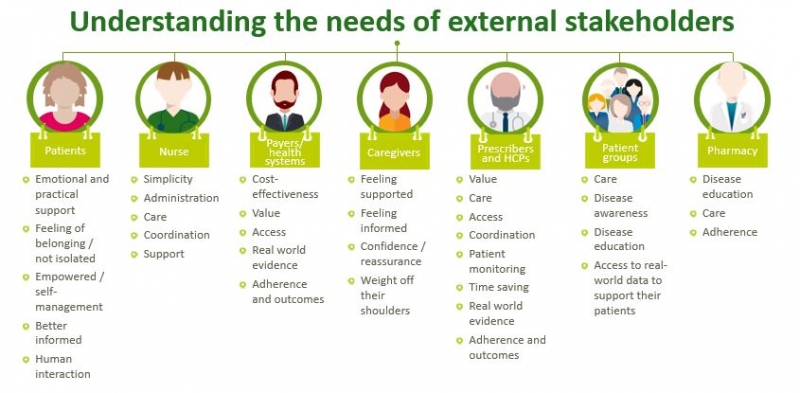With the rise of specialty medicines, the staggering cost of non-adherence and the demand for value from all stakeholders, it’s no surprise that patient support programs (PSPs) are becoming ‘cost of entry’ for some products.
However, it’s not enough to simply bolt on a one-size-fits-all support service around a new medicine; the bar is high, and the ambition is to deliver a truly differentiated service with measurable results.
In an earlier blog post, we identified five big pitfalls to avoid to deliver successful PSPs. In this article, we focus on the first two, asking what steps companies need to take to deliver high-quality, successful PSPs.
Step one: Define your objectives. Measure and report on them
While measurement and reporting may sound like issues to consider towards the end of a program they are actually among the first that should be addressed. Issues here are a huge reason why PSPs fail, because the right objectives were not set or the proper systems were not put in place to capture and report on the objectives.
Defining objectives
Within a multi-disciplinary team, the following questions may help offer some clarity and consensus on the reasons why you are investing in a PSP:
- What is the patient experience or journey throughout disease discovery, diagnosis and treatment?
- What and where are the therapy failure points, ie, what are the critical points in the patient journey where they are most likely to become non-adherent, and why?
- What is the revenue value of the medication per patient if adhered to properly throughout the course of treatment? How much does it cost to acquire a new patient vs retaining a current one?
- What are the challenges at this point in the lifecycle for this product? For example, is it a new, complex biologic requiring intensive support or perhaps an established, mass-market drug-device combination with declining market share?
- What are the expected health outcomes and how do these differ based on demographics and disease states?
- What improvements in the quality of life can patients expect?
- Who are the other stakeholders involved (for example, carers and HCPs) and what would treatment adherence and better outcomes mean to them?
Once these factors are understood, objectives can be established for a patient support program that will truly meet organizational goals while optimizing patient outcomes.
Measuring programs
Setting the right goals is a critical first step but it becomes meaningless without the proper measurement and reporting systems to ascertain whether the program is meeting them.
By deciding early on how to measure success – and how to measure the right things to support your commercial and medical decisions – you can plan systems and processes to collect, manage and report on the data.
It is much more difficult to set up systems and processes retrospectively once the program is up and running.
Program measurement relies on collecting a variety of data. Performance indicators could include:
- Quality indicators – for example, patient and HCP satisfaction, compliance, adverse event (ADE) or product technical complaint (PTC) reporting
- Productivity indicators – for example, site and patient enrolments, service uptake by patients
- Clinical indicators – for example, patient-reported outcomes such as quality of life, clinical outcomes, length of time on treatment, adherence, persistence, drop-off rates
- Value indicators – for example, return on objectives, cost-efficiency, sales performance, market share.
There’s a lot to think about and plan for but this data can have huge value. Data generated from PSPs can support regulatory requirements, for example, post-marketing surveillance studies, pricing and reimbursement strategies and scientific publications.
Remember that different internal departments and external stakeholders will want to see different outcomes from a PSP.
Step two: Engage with stakeholders inside and outside of your organization
Diseases don’t occur in a vacuum for those experiencing them, for those caring for patients, or for those trying to cure them. For any patient support program to be successful, it needs to transcend the operational silos so prominent within the pharmaceutical industry – starting with internal stakeholders.
Internal stakeholders
Departments must work together, not just in sharing data, but in coordinating goals and objectives from the start. Begin by mapping out all the internal stakeholders who will have a role in designing, delivering and using the outputs of the patient support program.
A multi-disciplinary workshop will allow you to understand what success looks like to each stakeholder. Certainly, each department will expect different outcomes from the program and will be able to use the data in different ways:
- Market Access and HEOR teams will value real world data (eg, disease outcomes, burden of disease and QoL) that can be used in peer-reviewed journals to support the value proposition and in negotiations with reimbursement authorities/formulary committees
- Brand teams want successful launches, penetration and increased market share
- Medical teams would like to see adherence and persistence data showing patients are staying on their medications as prescribed and clinical data showing the desired outcomes
- Pharmacovigilance needs to monitor the performance of products in a wider population and look for uncommon side effects.
Internal teams will be bought into the program when they can see the benefits for patients and “what’s in it for them”. You will then need to work with these different departments as you design the program, building in the steps to reach the desired outcomes.
External stakeholders
Patients may be at the heart of your program, but success relies on meeting the needs of a variety of external stakeholders. Each of these plays a key role in either the patient’s access to medication or their experience of the disease and treatment.
The image below gives an overview of the concerns and needs of different parties:
Understanding the needs of these stakeholders, where interactions takes place with the patient and how each stakeholder intersects, is unique to each therapy area and product. To uncover these insights and design a program that satisfies these different needs, consider a range of primary and secondary research methodologies:
- Therapy area and landscape analysis
- Literature and clinical trial review
- Patient and HCP interviews
- Social listening
- KOL engagement.
When you’re designing your questionnaire for patient interviews and interpreting the findings, there’s one huge challenge to keep in mind: to improve adherence, we need to change attitudes and behavior. And this kind of change is never easy.
Look out for the second article in the series very soon.
Nagore Fernandez is Head of Patient Services for EUCAN at Ashfield and Nareda Mills is President, Patient Services for Ashfield USA. Ashfield is part of UDG Healthcare plc.
 Primary Event: eyeforpharma Barcelona 2018Banner Ad:
Primary Event: eyeforpharma Barcelona 2018Banner Ad:  Précis: Delivering effective patient support programs (PSPs) is rapidly becoming an essential component of patient access but there are many pitfalls to avoidPremium`: Freemium`: Channels: ColumnTags: Patient Support ProgramsOriginal Article
Précis: Delivering effective patient support programs (PSPs) is rapidly becoming an essential component of patient access but there are many pitfalls to avoidPremium`: Freemium`: Channels: ColumnTags: Patient Support ProgramsOriginal Article



